|
|
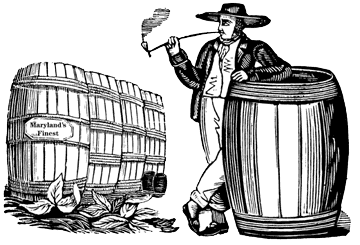 Need a Crop as Good As Gold Need a Crop as Good As Gold
by Russ Barnes
As Thanksgiving shoppers pushed their carts from aisle to aisle, the checkmarks tallied up turkey, sweet potatoes, cranberries, peas or green beans, sage, pecans. Given the festive juggernaut of our national feast, it’s no surprise that 95 percent of Americans put a roast turkey on the table this Thanksgiving, or that 45 million turkeys were shipped to satisfy this year’s holiday hunger.
Not that turkey sellers have a complete end-of-November food monopoly. The Pilgrims weren’t the only settlers giving thanks in the fall of 1621. There was Jamestown. A short time later, there were the plantation farmers of Bayside Maryland. They had their own Thanksgiving traditions that included turkey but also ham — just-out-of-the-smokehouse hams, stuffed with greens harvested from small gardens next to vast tobacco fields and seasoned with red and black pepper, celery and mustard seeds.
Lucky is the farmer who owns a turkey farm, for that’s a farmer who can pay the mortgage. The demand for turkey might appear natural and permanent, but it is human-made. President Abraham Lincoln proclaimed Thanksgiving a national holiday in 1863 as a response to a campaign organized by magazine editor Sara Joseph Hale. Widespread celebration of Thanksgiving began as a media event.
 |
| Maryland Secretary of Agriculture, Hagner Mister, understands firsthand the challenges facing one-time tobacco farmers. |
From the 17th century until recent times, Southern Maryland farmers owned at least a small piece of a lucrative and dependable monopoly: tobacco. Their agricultural product was known around the world as “Type 32,” an air-cured, light tobacco low in tar and nicotine.
But demand for tobacco has plummeted even as Maryland’s farmers are buffeted by other market changes brought about by new lifestyle tastes. To survive, our farmers have no choice but to adapt.
Which is just what state Agriculture Secretary Hagner Mister sees happening. “Maryland farmers are constantly changing and redirecting their operations to meet new products and opportunities.” Hope abounds, says Mister, himself a Calvert County tobacco farmer, because “a declining industry would be standing still, avoiding innovation, fighting to hang on to the status quo and refusing to change.”
 |
|
photo by Russ Barnes
|
Tobacco Bows Out
The biggest change is the loss of Maryland’s oldest cash crop, tobacco. In Southern Anne Arundel, Calvert, Charles and St. Mary’s counties, where tobacco has been king, more than half of tobacco farmers have signed on to the Maryland Tobacco Crop Conversion Program.
The “tobacco buy-out” works this way: Farm owners sign a contract agreeing to convert farm production from tobacco to any crop of their choice. To get the cash, they’ve also got to keep their property in some other sort of agricultural production for their lifetime.
Thus, says Christine Bergmark, director of agricultural development for the Tri-County Council for Southern Maryland, “The program is designed to save farmland for farming and preserve the quality of life in Southern Maryland.”
Payment is based on average crop sales in pounds during the years 1987 through 1999. When the farmer signs the buy-out contract, the State of Maryland annually pays that farmer $1 per average pound for 10 years.
“That’s a compelling deal,” says Maryland Department of Agriculture’s Tony Evans. “In the spring of 2000, when the buy-out program was introduced, the tobacco crop was in one of its best years ever. The quality of tobacco produced would ordinarily have sold for $2 a pound. But it sold for only $1.70 a pound. It wasn’t too hard for many farmers to see the writing on the wall.”
The ones who saw, signed. By the end of the first year of the buy-out, in June 2001, “an overwhelming 559 out of 981 eligible growers had signed contracts, representing 5.4 million pounds of tobacco,” says Bergmark. Calvert County accounted for 1.2 million and Anne Arundel for over 600,000 pounds of tobacco already taken out of production.
As soon as a tobacco farmer resolves the question of whether to sell out, another big question looms: What’s the next crop? Not far behind is a question bigger still: What’s the next crop for Maryland farmers?
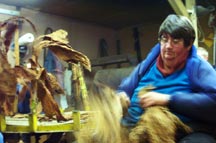 |
|
Tobacco farmer Betty Russell sits at a three-person assembly line where workers strip the stalks away from the tobacco leaves that chug along the belt.
photo by Russ Barnes
|
What’s in the Wings?
It’s likely no single crop will ever do for Maryland what King Tobacco did. The times have changed, explains Kevin Keany of Keany Produce in Landover, the region’s titan of produce distribution.
“The end-user market for fruits and vegetables has become much less monolithic over the past 10 years. It’s the specialty market that rules these days,” Keany says. “Not long ago, we all had four television channel choices. Now we have 110. The same kind of market fragmentation and specialization rules the produce industry today. There aren’t just three kinds of apples anymore. There are now 35 choices for apples, and those choices sometimes change weekly.”
A unilateral choice like turkey comes to consumers only once or twice a year nowadays.
What crop is next? That’s the question challenging not only the Bayside farmer who’s signed on to the Tobacco Crop Conversion Program but also any farmer who wants a profitable farm in our era of shifting consumer food preferences.
For Southern Maryland farmers, the answer is not as easy as a liking, say, for peacocks or sweet peas. Farmers today are business people, who’ve got to consider who will buy their crop and who will help them work it.
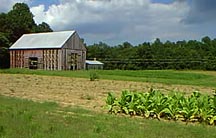 |
|
Lucky is the farmer who owns a turkey farm, for that’s a farmer who can pay the mortgage.
|
Seafood, Snails and Kiwis
One such farm, Russell Farm near Leonardtown, remains a medium-sized tobacco farm planting 24 acres.
Walter Russell sits behind a sheaf of cured tobacco leaves as he speaks about the fate of his crop. “This might be the last year we plant tobacco,” he says. “In another year, no tobacco farms may be left. We’ve been tempted to sign the buy-out, but haven’t yet. Next year, we have to think about it. The prices these days just make you look at things a different way.”
Walter and Betty Russell’s farm is now what might be called transitional. The Russells have diversified by cultivating 100 acres of vegetables and by maintaining nine greenhouses to raise bedding plants for home gardening.
“During the 1970s, we grew mainly tobacco,” says Russell. “That’s all we needed. Now we need every bit of our new production. The farm couldn’t make it without the produce and the greenhouse plants.”
Newer crops demand not only a different approach but a whole new lifestyle for the people who grow and tend them.
“Tobacco is kind of an all-year crop,” says Betty Russell as she sits at what looks like a merry-go-round but is in fact a circular conveyor belt around which a three-person assembly line of workers strips the stalks away from the tobacco leaves that chug along the belt.
“With tobacco, you take your crop to the auction anytime over about five days starting March 19 over at Hughesville or Upper Marlboro and sell it,” she says. “You get your money at the start of the growing season. With vegetables and greenhouse plants, you have to go to more places in order to sell.”
“Yes,” says Walter Russell, nodding in his wife’s direction. “Betty grew up on a produce farm in Glen Burnie. It takes a different kind of knowledge to run a produce farm.”
“My father taught me a lot about how to manage a produce farm,” she continues. “There’s different timing, a different season. You have to know the people who will buy. You need contacts all over. I have a list. I call people on that list from time to time and ask whether they need anything.”
What comes next is likely to be new to both Russells. They considered an import from Down Under, kiwi fruit. “But the fruit grows too small here in Southern Maryland,” says Russell, “so they wouldn’t sell at all, or you wouldn’t get a good price next to bigger fruit.”
They also considered aquaculture — specifically oyster growing — snail production, miniature rose bush cultivation and earthworm farming. Most, they couldn’t see themselves doing. Only one new product, roses, did they try. The crop failed.
Pretty Bouquets
Flowers seem to be working for John Prouty, who owns and operates a 200-plus acre farm near Huntingtown. Prouty was once a planter of 25 acres of tobacco. By 1999, his tobacco production had decreased to about six acres. Then he signed the tobacco buy-out. Now he sells bouquets of flowers at the Calvert County Farmers’ Market, roadside stands and a few grocery stores.
Of what he calls his “revolutionary” switch, Prouty says, “If I thought tobacco was labor intensive, it didn’t prepare me at all for how labor-intensive cut flowers would be. Labor is a major concern. We need labor only at the right time and at the right price. Another concern we have is that tobacco as a crop is pretty consistent — even boring — about what it needs. Flowers are neither consistent nor boring. Every type of flower has different needs. Each needs to be watered in a different way, for example.”
Irrigation is another new consideration. “Tobacco doesn’t need irrigation in Southern Maryland,” Prouty says, “because its roots are deep and wide. But flowers need supplemental water.”
The learning curve for switching crops is not trivial. “It’s a different culture,” Prouty says. “There’s so much we had to learn about cultivation, customer demand and where to market the flowers.” He sought out knowledge from other flower farmers as far away as California.
Prouty says that his cut-flower crop has not done badly, “but it could do better,” he says. “Although we’ve only been at this for two years, the farm is doing reasonably well financially because of the income from the buy-out and the incremental amount coming in from the cut flowers.”
The anchor for his farm is grain, 200 acres of it. Yet Prouty claims the grain crop alone could not make his farm profitable. At one time, tobacco provided the additional boost the farm needed. Now, along with the buy-out, that boost must come from flowers.
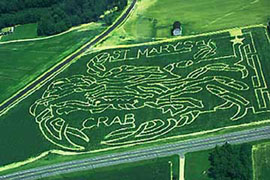 |
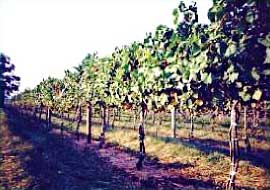 |
Helping to fill the agricultural void left by tobacco are ‘agri-tainment,’ like St. Mary’s County’s crab-shaped corn maze, and small-scale local vineyards. photos by Russ Barnes
Tulips, Grapes and Mazes
In Calvert County, Ralph Bucca operates Chesbayvu, a small vineyard overlooking the Bay near Huntingtown. Bucca represents a trend in Bayside agriculture: the part-time grower. In his part-time role, he may demonstrate that a specialized crop can succeed on a small-scale, stand-alone plot — three acres in this case — or as a specialized part of a bigger-scale, diversified farm.
“My experience seems to indicate that about 20 acres of vineyard is an optimum size economically and that it would produce at a rate comparable to tobacco,” said Bucca.
The economic index for vineyards, Bucca says, is based on tonnage — dollars per each ton of grapes produced — which he says should add up to $500 to $525 per ton for a well-managed vineyard. The average yield for each vineyard acre is two to five tons, depending on weather and other variables.
The Maryland Grape Growers Association in Westminster says conditions in the state are generally good for grape production. Bayside farms especially benefit from the favorable temperatures caused by the moderating water mass of the Chesapeake Bay. They also benefit from gently sloping fields, which generate downward drafts to siphon off cold air. Ralph Bucca’s vineyard enjoys both these benefits.
Even better, there is robust demand for Maryland grapes. “Supply,” according to the Maryland Grape Growers Association, “is roughly 50 percent of demand.”
One of the main obstacles to grape cultivation, however, is up-front capital investment. It can take as long as five years for annual grape harvests to reach maturity. And, as Bucca notes, “grape growing requires a different mentality, a shift in lifestyle.”
There are plenty of other viable — sometimes whimsical — ideas to keep Maryland farming. Southern Maryland has a climate similar to Holland’s, so tulips and other bulb plants are potential crops. Aquaculture, the use of farmland to grow seafood, is another good match, according to Noreen Eberly, head of aquaculture development for the Maryland Department of Agriculture.
Other farmers are turning to a phenomenon called agri-entertainment to help pay the mortgage. A farm product, if you will, called the cornfield maze is now sweeping the whole United States as a twisting, turning, labyrinthine craze. Tourists come out to the farm to explore the paths of a cornfield with fall stalks cut to form a maze of paths. Adults pay from $8 to $12 and children $5 to $7 at the farmer’s box office. The 15-acre cornfield maze at the Bowles Farms in St. Mary’s County has maze paths mown into the shape of a crab — but it only shows from the air.
Farm-Marketers
While one team of experts seeks the optimum money crop that fits conditions in Southern Maryland, other experts ponder another approach: Where’s the infrastructure? What kind of crop will get the best support in the agricultural distribution chain from Bayside soil to consumers’ pocketbooks?
In the ag business, “distribution chain” is a buzz-phrase that refers to everything it takes to get a crop to the end-user. That may take a host of middlemen: distributors, farm cooperatives, grocery stores, restaurants, roadside stands, farmers’ markets and more. Each of these intermediaries takes a slice of the farmer’s profit.
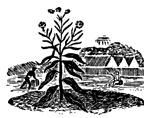 Which is why Tony Evans believes that the farmer’s route should be direct. He promotes farmers’ markets, having helped to develop the 67 now operating in Maryland. These markets, he says, not only allow farmland to sustain operating farms but also give the farmer more price-setting capability. Which is why Tony Evans believes that the farmer’s route should be direct. He promotes farmers’ markets, having helped to develop the 67 now operating in Maryland. These markets, he says, not only allow farmland to sustain operating farms but also give the farmer more price-setting capability.
Bruce Mertz, director of Future Harvest Chesapeake Alliance for Sustainable Agriculture, agrees that direct marketing is an answer for Southern Maryland farmers. Farms in his alliance, which are often organic, grow their produce for members who contract by the season. Part of the contract may be work on the farm, so in one way or another, they have a share in the produce they take home throughout the growing season.
“Supplying information directly to the consumer about food and how to use it increases sales,” he says.
(Future Harvest will convene a Farming for Profit and Stewardship conference, a regional forum showcasing marketing and production practices on January 18-19 in Hagerstown.)
Kevin Keany, who buys from farms and sells to grocery stores and restaurants, agrees that modern farmers benefit by becoming sophisticated marketers. Descriptions, recipes and explanations on food packages, in Keany’s experience, are powerful incentives to sales. “Chefs and food writers have a powerful influence on what food products sell in the specialty market,” he says.
Christine Bergmark dreams of allying agriculture to tourism to farming to lead Southern Maryland into agriculture’s 21st century. The spirit of a place is often associated with its food, she explains. Consider what chili peppers have done for Sante Fe, wine for Northern California or cheese for Wisconsin.
Catching the coattails of the tourism economic engine may be well worth the effort. “Visitors spend $1.9 billion annually in Anne Arundel County alone,” says Clare Vanderbeek of the Annapolis & Anne Arundel County Conference & Visitors Bureau. “A lot of people visit a place because of the food,” she adds. “And a lot of food is sold because it is associated in a positive way with a place.”
So as Chesapeake Country farmers say goodbye to tobacco, they may soon be thinking not only “What’s next?” but “What more?”
Helping to fill the agricultural void left by tobacco are ‘agri-tainment,’ like St. Mary’s County’s crab-shaped corn maze, and small-scale local vineyards.
photos by Russ Barnes
Copyright 2001
Bay Weekly
|